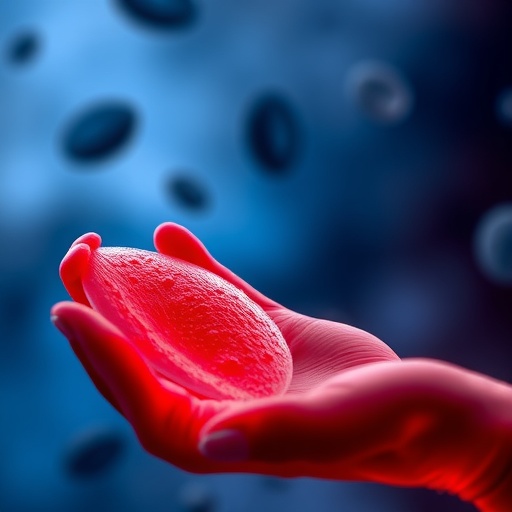In a groundbreaking advance for neuromuscular medicine, a team of researchers has unveiled an extensive catalog of serum protein biomarkers intricately linked with functional status and clinical progression in Duchenne muscular dystrophy (DMD). This large-scale study, recently published in Nature Communications, propels the quest for measurable, minimally invasive indicators that not only reflect disease severity but can forecast key clinical milestones in this devastating genetic disorder.
Duchenne muscular dystrophy, a relentless and life-shortening condition predominantly affecting boys, arises from mutations in the dystrophin gene, leading to progressive muscle degeneration. Despite significant strides in understanding its genetic underpinnings, clinicians and scientists have long grappled with the absence of robust, accessible biomarkers capable of tracking disease trajectory or gauging therapeutic response with high precision. The new research offers a seminal breakthrough by harnessing advanced proteomic technologies to profile hundreds of proteins circulating in patient serum, revealing patterns tightly correlated with muscle function and disease stage.
The investigative team employed cutting-edge mass spectrometry techniques augmented by sophisticated computational methods to scrutinize serum samples from a large and diverse DMD cohort. This approach enabled comprehensive quantification of protein abundance, capturing a proteomic signature that mirrors physiological changes characteristic of disease advancement. By integrating longitudinal clinical data, the researchers identified a constellation of proteins whose levels faithfully track with patients’ functional abilities, such as ambulation and respiratory capacity, as well as critical clinical milestones including loss of walking ability.
What sets this study apart is not merely the scale of the proteomic analysis but the clinical granularity it achieves. Whereas previous biomarker studies in DMD often focused on one or two candidate proteins, the current work simultaneously evaluates hundreds of potential indicators, thereby uncovering novel biomarkers that escaped prior attention. This comprehensive mapping offers an unprecedented resolution into the molecular shifts underpinning muscle deterioration, inflammation, and fibrosis—hallmarks of Duchenne progression—offering fresh avenues for monitoring and intervention.
Among the most compelling findings is the identification of certain proteins involved in muscle regeneration pathways and immune responses that exhibit distinct temporal dynamics aligned with disease milestones. The serum levels of these proteins not only reflect current muscle function but also possess predictive power, signaling impending transitions such as wheelchair dependence or respiratory decline. Such predictive biomarkers could radically transform clinical management by enabling earlier therapeutic adjustments tailored to individual disease trajectories.
The research further elucidates the complex interplay between systemic inflammation and muscle pathology in DMD. Proteins linked to innate immunity and inflammatory cascades show sustained elevations correlating with disease severity, suggesting ongoing immune engagement exacerbates muscle damage. These insights reinforce the rationale for emerging treatments targeting inflammatory pathways, with the identified biomarkers providing measurable endpoints for evaluating treatment efficacy in clinical trials.
Technically, the study leverages advances in high-throughput proteomics coupled with rigorous statistical modeling to ensure reproducibility and clinical relevance. The analytical pipeline seamlessly integrates quality control, normalization, and multivariate analyses to distill meaningful biological signals from the vast protein datasets. This methodological rigor sets a new standard for biomarker discovery studies in rare diseases marked by heterogeneous clinical presentations.
Clinicians and patient advocacy groups have hailed the findings as a transformative leap toward precision medicine in DMD. The availability of reliable serum biomarkers could reduce reliance on invasive muscle biopsies and subjective motor assessments, which often suffer from variability and patient burden. Instead, routine blood tests quantifying these protein signatures could become instrumental in both routine practice and clinical research, expediting diagnosis, stratifying patients for trials, and monitoring responses to emerging gene and cell therapies.
Critically, the authors underscore the potential for these serum markers to serve as surrogate endpoints in future clinical trials, accelerating drug development pipelines that have faced setbacks due to subjective or insensitive outcome measures. By providing objective, quantifiable biomarkers directly linked to functional status, therapeutic efficacy can be assessed more rapidly and accurately, paving the way for expedited regulatory approvals and broader treatment access.
Moreover, the study’s comprehensive proteomic atlas offers a valuable resource for interdisciplinary investigations, revealing biochemical pathways and molecular players hitherto underappreciated in DMD pathogenesis. Future research building on these findings may uncover novel drug targets or combination therapeutic strategies aimed at modulating immune responses, enhancing muscle repair, or preventing fibrosis.
The international collaboration spans multiple clinical centers and research institutions, emphasizing the importance of large, well-characterized patient cohorts in biomarker discovery. The diversity of samples enhances the generalizability of findings across age groups, disease stages, and treatment regimens, addressing a key limitation of prior smaller studies restricted by sample size and heterogeneity.
This pivotal research arrives at a moment when the DMD therapeutic landscape is rapidly evolving, with promising gene editing, exon skipping, and cell-based therapies entering the clinical arena. The integration of precise biomarkers as demonstrated could serve as a linchpin for personalized medicine, tailoring interventions according to individualized biomarker profiles and improving patient outcomes.
Looking ahead, translational efforts will focus on validating the identified biomarker panels in independent cohorts and developing standardized assays suitable for routine clinical laboratories. Ensuring accessibility and affordability will be essential to realize the full impact on patient care worldwide, especially in resource-limited settings where diagnostic and monitoring options remain scarce.
The study also highlights the power of proteomics as a tool not only to decode disease biology but to generate actionable clinical insights. By depicting a dynamic biochemical landscape evolving through the natural history of Duchenne muscular dystrophy, it bridges the gap between molecular research and bedside application, ultimately striving to extend and enhance quality of life for affected individuals.
In conclusion, this comprehensive serum proteomic profiling study marks a watershed moment in Duchenne muscular dystrophy research. It delivers a robust framework of biomarkers linked to functional decline and clinical milestones, offering a transformative approach to disease monitoring, prognostication, and therapeutic evaluation. As these protein signatures move closer to clinical implementation, they herald a new era where blood-based tests could provide real-time windows into muscular health, empowering clinicians and patients alike in the fight against this relentless disease.
Subject of Research: Duchenne muscular dystrophy biomarkers and disease progression
Article Title: Large-scale serum protein biomarkers discovery associated with function and clinical milestones in Duchenne muscular dystrophy
Article References:
Ikelaar, N.A., Barnard, A.M., Eng, S. et al. Large-scale serum protein biomarkers discovery associated with function and clinical milestones in Duchenne muscular dystrophy. Nat Commun 16, 9073 (2025). https://doi.org/10.1038/s41467-025-64146-y
Image Credits: AI Generated
Tags: clinical progression indicators DuchenneDuchenne muscular dystrophy biomarkersdystrophin gene mutationslongitudinal clinical data integrationmass spectrometry in biomarker discoveryminimally invasive biomarkers DMDmuscle degeneration biomarkersneuromuscular medicine advancementsproteomic technologies in DMDserum protein biomarkers DMDtherapeutic response gauging DMDtracking disease severity DMD





